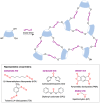Cyclodextrin Inclusion Complexes for Improved Drug Bioavailability and Activity: Synthetic and Analytical Aspects
- PMID: 37765313
- PMCID: PMC10534465
- DOI: 10.3390/pharmaceutics15092345
Cyclodextrin Inclusion Complexes for Improved Drug Bioavailability and Activity: Synthetic and Analytical Aspects
Abstract
Many active pharmaceutical ingredients show low oral bioavailability due to factors such as poor solubility and physical and chemical instability. The formation of inclusion complexes with cyclodextrins, as well as cyclodextrin-based polymers, nanosponges, and nanofibers, is a valuable tool to improve the oral bioavailability of many drugs. The microencapsulation process modifies key properties of the included drugs including volatility, dissolution rate, bioavailability, and bioactivity. In this context, we present relevant examples of the stabilization of labile drugs through the encapsulation in cyclodextrins. The formation of inclusion complexes with drugs belonging to class IV in the biopharmaceutical classification system as an effective solution to increase their bioavailability is also discussed. The stabilization and improvement in nutraceuticals used as food supplements, which often have low intestinal absorption due to their poor solubility, is also considered. Cyclodextrin-based nanofibers, which are polymer-free and can be generated using environmentally friendly technologies, lead to dramatic bioavailability enhancements. The synthesis of chemically modified cyclodextrins, polymers, and nanosponges based on cyclodextrins is discussed. Analytical techniques that allow the characterization and verification of the formation of true inclusion complexes are also considered, taking into account the differences in the procedures for the formation of inclusion complexes in solution and in the solid state.
Keywords: anticancer drug carriers; bioavailability enhancement; cyclodextrin analytical techniques; cyclodextrin nanofibers; cyclodextrin synthesis; drug–cyclodextrin inclusion complexes; nanosponges.
Conflict of interest statement
The authors declare no conflict of interest.
Figures

























Similar articles
-
Investigation of Cyclodextrin-Based Nanosponges for Solubility and Bioavailability Enhancement of Rilpivirine.AAPS PharmSciTech. 2018 Jul;19(5):2358-2369. doi: 10.1208/s12249-018-1064-6. Epub 2018 Jun 4. AAPS PharmSciTech. 2018. PMID: 29869305
-
Oral supplementation of solvent-free kynurenic acid/cyclodextrin nanosponges complexes increased its bioavailability.Colloids Surf B Biointerfaces. 2023 Feb;222:113101. doi: 10.1016/j.colsurfb.2022.113101. Epub 2022 Dec 15. Colloids Surf B Biointerfaces. 2023. PMID: 36529037
-
Enhancement of Bioavailability of Non-nucleoside Reverse Transciptase Inhibitor Using Nanosponges.AAPS PharmSciTech. 2017 Jul;18(5):1728-1738. doi: 10.1208/s12249-016-0636-6. Epub 2016 Oct 18. AAPS PharmSciTech. 2017. PMID: 27757921
-
Analytical techniques for characterization of cyclodextrin complexes in aqueous solution: a review.J Pharm Biomed Anal. 2014 Dec;101:238-50. doi: 10.1016/j.jpba.2014.02.022. Epub 2014 Mar 12. J Pharm Biomed Anal. 2014. PMID: 24680374 Review.
-
Cyclodextrin-Modified Nanomaterials for Drug Delivery: Classification and Advances in Controlled Release and Bioavailability.Pharmaceutics. 2021 Dec 10;13(12):2131. doi: 10.3390/pharmaceutics13122131. Pharmaceutics. 2021. PMID: 34959412 Free PMC article. Review.
Cited by
-
The antitumor mechanisms of glabridin and drug delivery strategies for enhancing its bioavailability.Front Oncol. 2024 Dec 11;14:1506588. doi: 10.3389/fonc.2024.1506588. eCollection 2024. Front Oncol. 2024. PMID: 39723390 Free PMC article. Review.
-
Formulation and Characterization of β-Cyclodextrins-Nitazoxanide Inclusion Complexes: Enhanced Solubility, In Vitro Drug Release, and Antiviral Activity in Vero Cells.Pharmaceutics. 2024 Nov 21;16(12):1494. doi: 10.3390/pharmaceutics16121494. Pharmaceutics. 2024. PMID: 39771475 Free PMC article.
-
Effect of Reaction Parameters on the Synthesis of Cyclodextrin-Based Nanostructured Polymers for Drug Delivery.Polymers (Basel). 2025 Mar 7;17(6):709. doi: 10.3390/polym17060709. Polymers (Basel). 2025. PMID: 40292530 Free PMC article.
-
Advanced drug delivery systems for the management of local conditions.Ther Deliv. 2025 Mar;16(3):285-303. doi: 10.1080/20415990.2024.2437978. Epub 2024 Dec 29. Ther Deliv. 2025. PMID: 40020739 Free PMC article. Review.
-
Chitosan and Cyclodextrins-Versatile Materials Used to Create Drug Delivery Systems for Gastrointestinal Cancers.Pharmaceutics. 2023 Dec 27;16(1):43. doi: 10.3390/pharmaceutics16010043. Pharmaceutics. 2023. PMID: 38258054 Free PMC article. Review.
References
-
- Duchêne D., editor. New Trends in Cyclodextrins and Derivatives. Editions de Santé; Paris, France: 1991.
Publication types
Grants and funding
LinkOut - more resources
Full Text Sources

